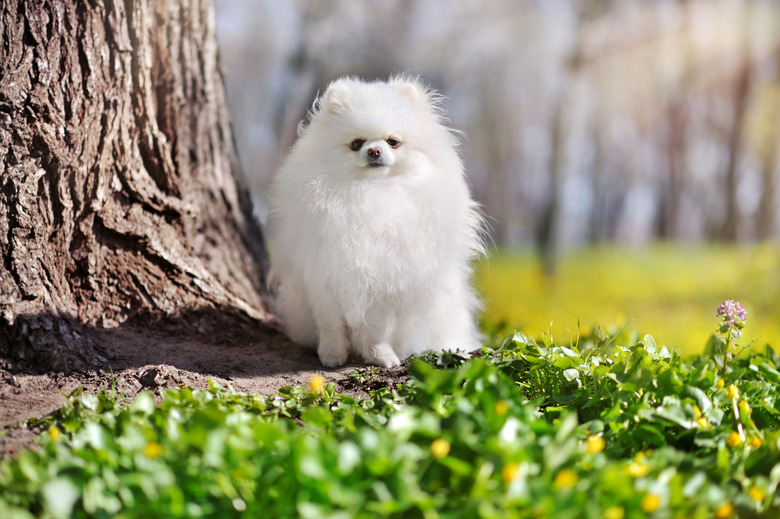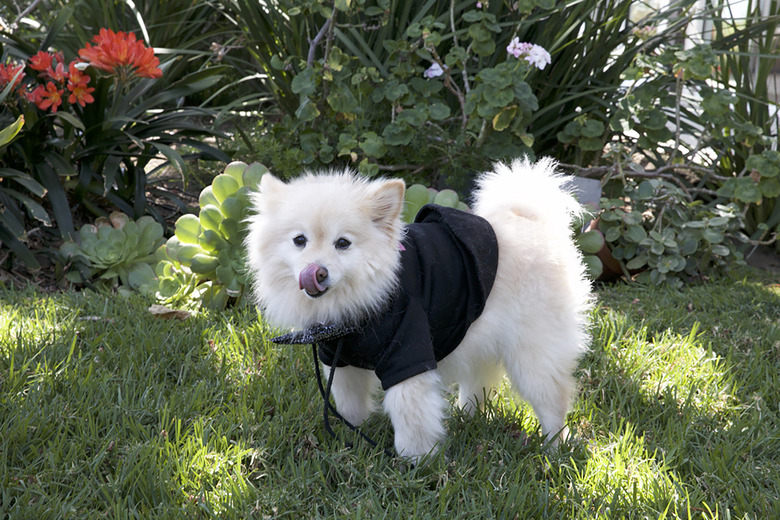Hair Loss In Pomeranians
Pomeranians have lush double coats, with a long, coarse outercoat flowing over a soft, dense undercoat. This small dog's characteristic fluffy fur is highlighted by their signature plumed tail and a fur frill extending over the shoulders. All dogs shed, but it can be particularly troubling if your Pom starts to lose their hair. A bald Pomeranian or a hairless adult Pomeranian is disconcerting, and alopecia is often the cause. However, thin coats on puppies are normal.
How much do Pomeranians shed?
How much do Pomeranians shed?
Despite all their hair, Pomeranians shed considerably less on a daily basis than their short-haired counterparts who may shed more year-round. There are, however, times when Pomeranians experience heavy shedding, and you'll need to have your lint rollers and vacuum cleaner ready. Read on to learn more about specific times when these fluff balls shed their coat.
At what age do Pomeranians start shedding?
At what age do Pomeranians start shedding?
Your Pomeranian dog will first start to shed their puppy coat around 4 to 6 months of age. During this shed, their coat will go from puppy fur to the double coat that adults have. It's possible that your puppy's coat color may change. Their new coat will have the outer guard hairs, which are coarse, long hairs designed for protection from the elements. The undercoat is soft and keeps your pup warm.
When do Pomeranians shed?
When do Pomeranians shed?
The three most common times when Pomeranians shed are:
- When a puppy is blowing their baby coat and their adult coat comes in.
- During seasonal shedding, which happens in the spring and in the fall. The shedding season can last six to eight weeks.
- When a female Pom weans her pups and also when she is in estrus (in heat).
Types of Pomeranian shedding
Types of
Pomeranian
shedding
Pomeranians undergo various types of shedding:
- Puppy shedding: This stage is also referred to as "puppy uglies" due to patches of fur missing from parts of their body (called alopecia.) Despite the complete transition from puppy coat to adult coat, this is the lightest shed a Pom has.
- Adult shedding or seasonal shedding: This is when an adult dog blows their coat twice a year to prepare for a significant season change in spring and fall. This happens more in climates with severe seasonal temperature shifts, such as cold climates where your dog needs a winter coat. An indoor dog without these climate cues usually sheds equally throughout the year.
- Hormonal shedding: When a female completely sheds her coat during a heat cycle or after weaning her puppies, it's called hormonal shedding. This is the heaviest shed a Pom can have, and it can take six to eight months for her coat to fully return. Unspayed females shed more than male Poms. Spayed female Poms and male Poms (neutered or not) shed about the same amount.
- Medical conditions: There are various medical conditions that can cause hair loss (alopecia) in dogs. Some of these are Alopecia X; Cushing's disease (hyperadrenocorticism); a less active thyroid gland (hypothyroidism); allergies; ectoparasites, such as fleas or mites; nutritional deficiencies; and stress or anxiety.
Pomeranian puppy shedding
Pomeranian puppy shedding
Pomeranians go through a stage in the first year of life called puppy uglies, which is when their fluffy puppy coat is shed. It might look as though there's something wrong with your puppy, but the scraggly coat is normal at this age. Eventually, the Pom's adult fur grows in, but first they must go through an awkward stage of sporting thin, wispy hair. Typically, this will last five or six months, from the time they're 4 to 6 months old until around 10 to 12 months old.
Note that grooming a Pomeranian is important at this young age. Brush the puppy carefully and frequently with a soft brush to break up tangles, remove dead fur, and help stimulate blood circulation to encourage new hair growth. Bathing at least every three weeks at this stage is a good idea to remove excess oils and prevent clogged pores. Use a quality dog shampoo specifically formulated for young Pomeranians. Also, make sure that your puppy eats quality food.
Alopecia X in Pomeranians
Alopecia X in Pomeranians
Alopecia X is mild to severe hair loss (alopecia) with no known cause, and it's one of the few hair health issues that can plague Pomeranians. Other dog breeds affected by this condition are chow chows, keeshonds, and Alaskan malamutes. Veterinarians also call this condition adult onset growth hormone deficiency, while breeders often dub it black skin disease. It's also referred to as hair cycle arrest or coat cycle arrest.
Alopecia X in Pomeranians is abnormal hair loss and can occur when the dog is between 1 and 10 years old. It might happen after the puppy ugly stage when instead of the adult coat growing in, the dog loses more fur due to genetics, thyroid dysfunction, adrenal dysfunction, or parasites on the dog's skin. It sometimes involves the skin pigment changing color as well. Otherwise, there are no symptoms that identify the condition.
Various medications, such as trilostane, lysodren, and medroxyprogesterone acetate, have been used to treat dogs with Alopecia X. The results vary, and some dogs will experience partial hair regrowth, while others may experience complete hair regrowth. Dogs who are not spayed or neutered may experience hair regrowth after spaying or neutering.
Other causes of hair loss in Pomeranians
Other causes of hair loss in Pomeranians
Hair loss can also go hand in hand with depression, poor diet, or health problems involving the liver or kidneys. If you suspect any health issues or notice a change in your Pom's behavior, consult a veterinarian immediately. You can also talk with your veterinarian about supplements that may benefit your Pom's coat, such as omega-3 fatty acids. There are also special dog foods designed for Pomeranians.
Pomeranian grooming and shedding tips
Pomeranian grooming and shedding tips
Some grooming tips for Pomeranians include:
- Brush your Pom's coat twice a week to keep it in good shape. If you brush the coat more often or have it trimmed to the undercoat by a groomer, you run the risk of causing excess hair loss due to overgrooming.
- During times of shedding, brush your Pom daily, such as with a slicker brush or pin brush. (A pin brush has fewer bristles than a slicker brush.) These and other de-shedding tools are easily found on Amazon.
- Don't cut a Pomeranian's fur short. Shaving down a Pom's coat might seem like a good idea at the time, but you run the risk that it will never grow back with the same fullness. This is called post-clipping alopecia.
- Bathe your Pom every six to eight weeks unless they have a medical condition where your veterinarian has instructed you to do otherwise.
The bottom line
The bottom line
A Pomeranian's coat sheds for different reasons, and the amount of hair loss varies with the type of shed. The three primary sheds are when a Pom puppy loses their baby coat (which is the lightest shed), seasonally during spring and fall, and when a female dog is in heat or weans her litter of puppies. This third reason is the heaviest time for Pom shedding. There are also medical reasons that may cause a Pom to experience excessive shedding. If you're concerned about how much your Pom is shedding, talk with your veterinarian.

